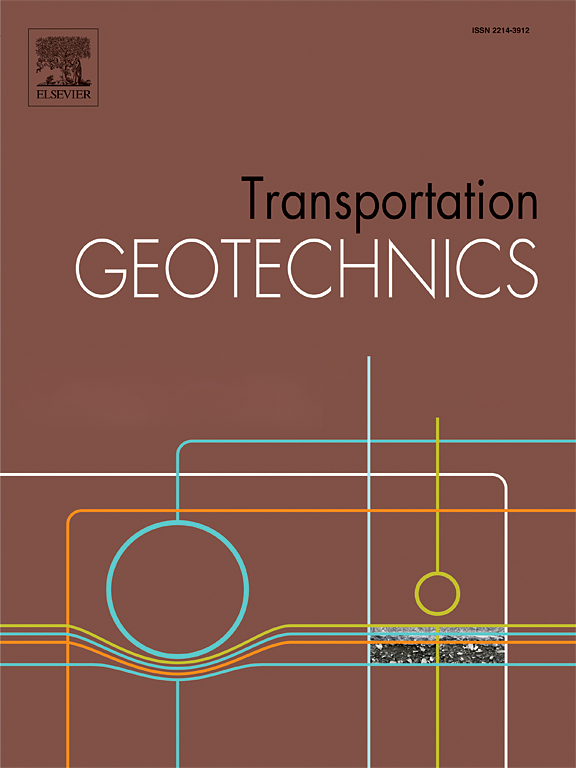Wave finite element method for computing the dynamic response of periodic structures with transition zones and subjected to moving loads: Application to railways tracks with damaged or reinforced zones
IF 4.9
2区 工程技术
Q1 ENGINEERING, CIVIL
引用次数: 0
Abstract
The dynamics of transition zones linking two semi-infinite periodic structures is the subject of numerous researches, particularly in the railway track domain. For periodic structures, the Wave Finite Element (WFE) method is a numerical method helping the computation of the dynamics of these structures by reducing the consideration of the spatial domain to a few periods consisting of domains whose properties differ from those of the two right and left semi-infinite periodic structures. The WFE method firstly consists in reducing the degrees of freedom (DoFs) of one spatial period (substructure) to those of the borders of this substructure. Then, using the Floquet’s theorem, these DoFs are computed by the mean of a wave analysis. This article presents new developments in the Wave Finite Element (WFE) method to compute the mechanical response of transition zones linking two semi-infinite periodic structures, with the aim of making complex computations affordable and of reducing the computation time. The WFE method is applied on each periodic structure to write the response of the boundaries of the central zone in terms of left-going and right-going waves. Some amplitudes of these waves can be directly computed from the external load. To get the unknown wave amplitudes, the wave equations are combined with the dynamic equilibrium equation of the central zone. Thus, this method reduces the computation of the dynamics of a structure containing a transition zone linking two semi-infinite periodic zones to a wave problem at the boundaries of the transition zone coupled to a FEM modelling of the transition zone. In this paper, writing the problem only in terms of wave amplitude allows a much better conditioning of the linear system giving the solution to the problem compared to classical methods combining wave amplitudes and usual degrees of freedom at the mesh nodes. Special developments are made to account for moving loads on the whole infinite structure. The case of moving loads is particularly considered because of its applications to railways. For simple geometries, numerical studies show a strong agreement between results obtained with this method and other experimental and analytical results. More complex examples are given for railways tracks with damaged or reinforced zones. The calculation of stresses and damage criteria in components of the track for healthy, damaged and repaired railway tracks shows the interest in repair.
移动荷载作用下带过渡区周期性结构动力响应计算的波动有限元法:在带损伤或加固区的铁路轨道上的应用
连接两个半无限周期结构的过渡带的动力学是许多研究的主题,特别是在铁路轨道领域。对于周期结构,波动有限元(WFE)方法是一种数值方法,通过将空间域的考虑减少到几个周期,这些周期由与两个左右半无限周期结构的性质不同的域组成,有助于计算这些结构的动力学。WFE方法首先是将一个空间周期(子结构)的自由度降低到该子结构边界的自由度。然后,利用Floquet定理,用波浪分析的平均值计算这些自由度。本文介绍了波浪有限元(WFE)方法在计算连接两个半无限周期结构的过渡区力学响应方面的新进展,目的是使复杂的计算负担得起并减少计算时间。在每个周期结构上应用WFE方法,以左向波和右向波的形式写出中心区域边界的响应。这些波的一些振幅可以从外部载荷直接计算出来。将波动方程与中心区的动力平衡方程相结合,得到未知的波动幅值。因此,该方法将包含连接两个半无限周期区域的过渡区结构的动力学计算简化为过渡区边界的波动问题,并对过渡区进行有限元模拟。在本文中,与结合网格节点的振幅和通常自由度的经典方法相比,仅以振幅的形式编写问题可以更好地调节线性系统,从而给出问题的解决方案。为了考虑整个无限结构上的移动荷载,进行了特殊的发展。移动载荷的情况特别考虑,因为它的应用在铁路。对于简单的几何形状,数值研究表明,用这种方法得到的结果与其他实验和分析结果非常吻合。对于带有破损或加固带的铁路轨道,给出了更为复杂的例子。对于健康、受损和修复的铁路轨道,计算轨道部件的应力和损伤准则表明了对修复的兴趣。
本文章由计算机程序翻译,如有差异,请以英文原文为准。
求助全文
约1分钟内获得全文
求助全文
来源期刊

Transportation Geotechnics
Social Sciences-Transportation
CiteScore
8.10
自引率
11.30%
发文量
194
审稿时长
51 days
期刊介绍:
Transportation Geotechnics is a journal dedicated to publishing high-quality, theoretical, and applied papers that cover all facets of geotechnics for transportation infrastructure such as roads, highways, railways, underground railways, airfields, and waterways. The journal places a special emphasis on case studies that present original work relevant to the sustainable construction of transportation infrastructure. The scope of topics it addresses includes the geotechnical properties of geomaterials for sustainable and rational design and construction, the behavior of compacted and stabilized geomaterials, the use of geosynthetics and reinforcement in constructed layers and interlayers, ground improvement and slope stability for transportation infrastructures, compaction technology and management, maintenance technology, the impact of climate, embankments for highways and high-speed trains, transition zones, dredging, underwater geotechnics for infrastructure purposes, and the modeling of multi-layered structures and supporting ground under dynamic and repeated loads.
 求助内容:
求助内容: 应助结果提醒方式:
应助结果提醒方式:


